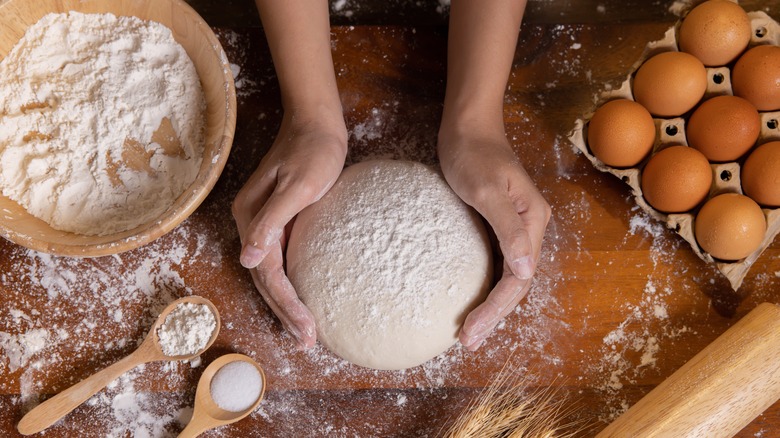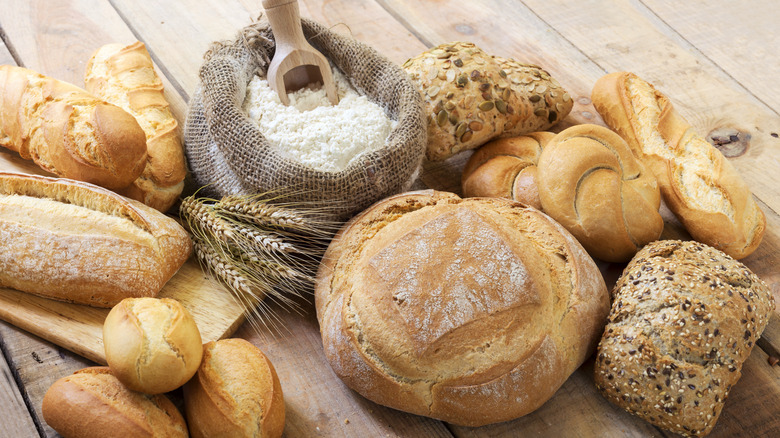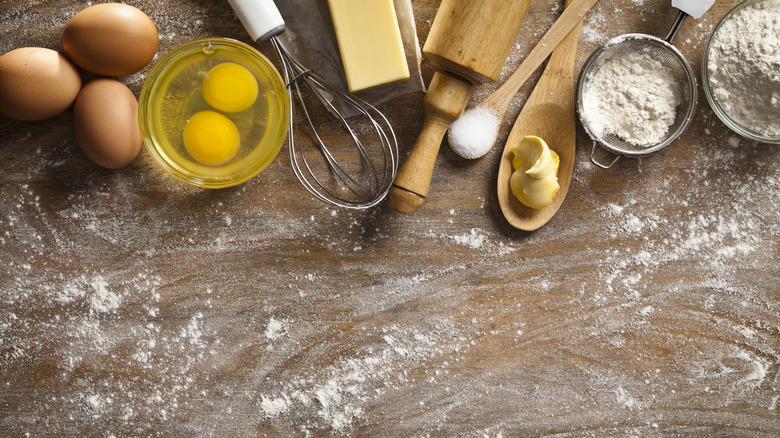The One-To-One Bread Flour Substitute You Should Memorize
The sheer variety of flours that sit on a supermarket shelf can throw anyone into a tizzy. There are self-raising flours that don't need additional leaving agents and stretchy 00 ones; there are fine instant flours and those made from nuts, grains, and cereals. For baking alone, there's all-purpose, whole wheat, cake, and pastry flours to choose from, too. Though none of them will do if it's bread that you're baking, as there's a bag of flour meant specifically to do the job. But what happens if you don't have it?
Most things in the kitchen can be swapped in a pinch, and bread flour is no different. All you need is the trusty ol' all-purpose flour — the same ingredient that can also easily substitute for cake flour. Even better, it's an incredibly hassle-free swap, as all-purpose flour is a 1:1 substitute that can replace bread flour in equal measure. That said, there are certain differences between the two. Bread flour has protein content that's anywhere between 12-14% whereas all-purpose flour's protein clocks in at 10-12%. The difference in protein content may leave changes in your baked goods, so it's ideal to make certain adjustments before you proceed.
What you should know before making the swap
An important differentiating factor between the many varieties of flour is the wheat that they are milled from and how hard that wheat is. Harder varieties give rise to flours that have less starch but more protein, which in turn means that they also have more gluten. Whereas all-purpose is made by blending hard and soft wheat (which dilutes its protein content), the fluffy powder used to bake breads is milled from hard wheat alone, making it the most protein-rich option.
Because the high protein content in bread flour enables more gluten development, it yields dough that's more elastic and chewy, and which holds its structure well upon baking. When swapping it with all-purpose flour, you may notice a slight difference in the chewy texture and the structure of the end result — though it's not always significant enough in things like breads and pizza bases to deter the substitution.
When replacing bread flour though, stick to all-purpose that's unbleached — it already has comparatively less protein and bleaching only compromises this further. Another thing to take into account is the liquid in your recipe. Flours with more protein absorb more liquid, so doughs and batters made from bread flour require higher amounts of water and oil. Hold back about a quarter of the liquid required in the recipe when using all-purpose — getting this ratio wrong is a mistake that can quickly make your homemade bread fall apart.
More handy baking swaps to remember
Making a substitution in baking can seem like a daunting task, but it doesn't have to be if you imprint certain common swaps in your memory just like the all-purpose substitution for bread. For example, eggs are frequently used to give breads like brioche a smooth, moist, and airy texture. When you want to skip the eggs and make the bread vegan, all you need is ground flaxseeds or chia seeds. A tablespoon of either one whisked into 3 tablespoons of water will replace one egg. If it's just the whites that need replacing, whip 2 tablespoons of aquafaba into a puffy cloud for every egg white in your recipe.
Baking soda and baking powder are two of the most common ingredients used to help breads rise, but if you don't have either one on hand, it's good to remember that they can swapped for each other. Baking soda can be substituted with baking powder, though you'll need to add thrice the amount and reduce any additional salt. If it's a teaspoon of baking powder that needs to be swapped, use a 1/4-teaspoon of baking soda and whisk it with a 1/2-teaspoon of cream of tartar or a whole teaspoon of lemon juice or vinegar. Any fats used to stretch the gluten in bread can be switched too: Vegetable oil can be substituted with equal amounts of mayonnaise or butter, and butter can be replaced with half the quantity of applesauce. Truly, baking substitutions can be as easy as that!



